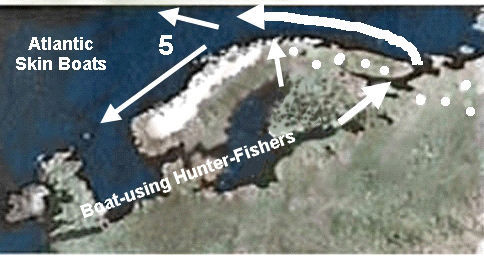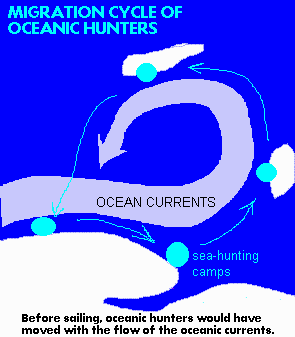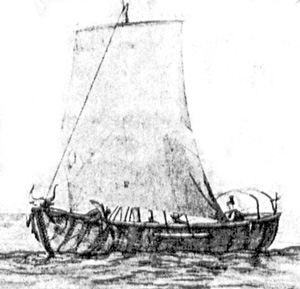3. EXPANSIONS
TO SEA
THE
DEVELOPMENT OF SEAGOING SKIN BOATS AND EXPANSION TO THE ARCTIC 6,000-4,000BP
Synopsis:
The boat peoples that emerged in the lands released from the grip of
the glaciers did not expand just to the east to the Ural Mountains
and beyond to the Ob River basin, but also towards the north. The
land was so water-filled that it was possible to travel easily by boat
to the White Sea. The peoples who did so were obviously descended from
the archeological "Kunda Culture" originally established up the east
coast of the swollen Baltic Sea, which extended up into Finland. The
artifacts from the Kunda Culture offered not just stone adzes for
making dugouts, but also large harpoons suggesting these people had
learned how to go out into the sea and hunt sea mammals like seals.
Naturally such people, being accustomed now to hunting in the open
seas, would be more interested in expanding into further open sea, than
returning to marshes and lakes. This produced a branch of the Kunda
Culture that reached the White Sea and from there continued west to the
bountiful waters of arctic Norway, warmed by the Gulf Stream reaching
there. And from there the seagoing boat culture spread around the
arctic ocean and south along the ocean coasts, possibly following whale
migrations
The Kunda Culture Branching North to the Arctic Ocean
MIGRATIONS TO ARCTIC NORWAY
The Kunda Culture, already discussed earlier, along
with the Maglemose Culture, not only expanded east as far as the Urals,
but also branched northward. In this article we will present the quite
amazing story of expansion from the prehistoric Baltic Sea to Lake Onega, then White Sea, then arctic
Norway facilitated by the invention of the skin boat because trees
large enough for seagoing dugouts were not available.
The following archeological map of cultures was
presented earlier. It shows how archeologists have categorized the
artifacts they have unearthed and the locations they were found.
Figure 1
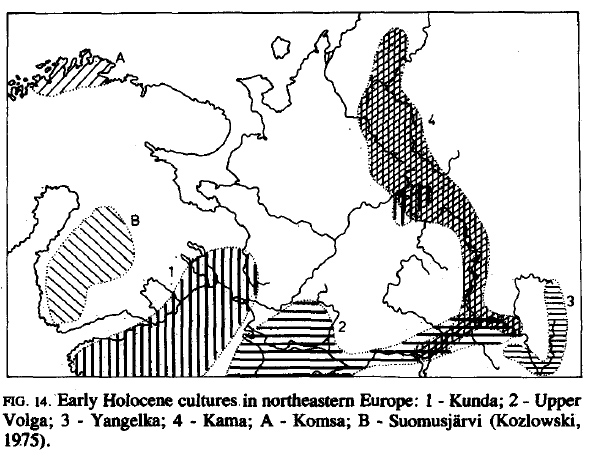
Note that archeology names material cultures according to ways in which
people adapted to new environments. It did not mean the people or
culture changed significantly.
Note first the 'official' Kunda Culture shown in vertical hatching.
Note they have identified the same artifacts at the end of the Dvina
River overlapping the Kama cross-hatched area. Given that there were
boat peoples, that means in fact, the entire Divna contained the Kunda
Culture. Furthermore the Volga, and Kama cultures would have been
descended from it - unless they are more directly connected to the
Maglemose culture of the south Baltic, not shown. But then how
different was the Maglemose and Kunda Cultures from each other. They
overlap at the southeast Baltic.
In terms of the story of the expansion of the Kunda
Culture into the arctic, the relevant culture is the one at the top of
Norway, the Komsa Culture. As we will see below, they must have arisen
from the practice of the Kunda Culture descendants at Lake Onega from
making annual journeys to the White Sea and further, to harvest the
waters of arctic Norway, warmed by the Gulf Stream (or "North Atlantic
Drift") As we will see, rock carvings show the same skin boat
with moose-head prow at the Norwegian arctic coast as in rock carvings
at the White Sea and at Lake Onega south of the White Sea.
Rock carvings found at the Norwegian island of Sørøya, show
images of a light dugout, too small for ocean waves, but also a
high-prowed vessel with a moose-head prow These people obviousy
also had dugouts, but, like the Khanti dugouts, were too small to
navigate in open seas. Possibly the Inuit kayak , which enclosed the
top to allow waves to break over the top, was in effect an adaptation
of the tiny one-person northern dugout, to deal with high waves and
these could be built without need for any tree.
These details practically prove their utlimate Kunda
Culture origins.for the peoples who visited arctic Norway,
Thus to be correct, the map should show the Kunda
Culture extending north from Lake Onega to the White Sea and then west
to arctic Norway.
While some archeologists have suggested the Komsa
people and others who left rock carvings on arctic islands, came up the
Norwegian coasts, why would they travel north in
ocean waves along a forbidding shore with glaciers. It is possible but
unlikely. Origins from the east, from the White Sea,
is proven from the locations of the rock carvings showing the moosehead
prow skin boats. Furthermore, along the entire way, seahunters will be
invited to continue from the bounty of sea life. If one came up the
Norwegian coast, there would not be much that is exciting until they
got north of the Lofotens, where the regions were affected by the
warmed waters,
The following Figure 2, presents a map intended to
depict this expansion into the arctic seas: It presents a fourth step
in the expansion of boat peoples depicted on maps in Figure 2 of the
last chapter (2. ORIGINS AND EXPANSION) which focuses on the expansion
eastward to the Urals through rivers.
It is because of the glaciers and glacier
meltwaters along the arctic coast, that the story of the expansion into the arctic occurs a
little later than the expansion to the Urals and beyond.
This map assumes tha the reindeer
and reindeer people have arrived in the north as well. The story of the
reindeer and reindeer people is still unclear, since the movement of
reindeer to arctic Scandinavia was dependent on the shriking of the
glaciers, to expose tundra along the arctic coast along which the
reindeer could travel. For a time since 10,000 years ago the world
climate was warmer than today and glaciers were still only half-melted,
and the tundra may have been swamped with glacial meltwater.
. Figure 2
It is unclear if European reindeer herds migrated north
through the mountains, because for a long time the glaciers covered the
mountains. Reindeer can survive in mountains but have to be able to paw
through snow to get at lichens. As long as there were thick glacial
fields reindeer could not survive. But recently, the science of
population genetics has discovered the N-halogroup carried by men,
generation after generation, and since it shifted north since the Ice
Age, and today is most common in peoples descended from reindeer
people, the N-haplogroup frequencies are a trail of the migration and
diffusion of men with ancestry in Asian reindeer people.
The
migration of reindeer westward from the polar Urals along with the
reindeer people carrying the Y-DNA N1c1-haplogroup suggests reindeer
migrations westward from the vicinity of the polar section of the Ural
Mountains. The reindeer people with this N1c1-haplogroup would have
followed. (The entry of this haplogroup into men of Finno-Ugric
cultures would have occurred from some of these reindeer people
converting to the boat people way of life, and becoming a part of it,
diffising their genetics both east-to-west from the Urals and
north-south from northern Finland. Language change too would have
occurred from this, contrary to the traditional explanations.)
This westward migration of the reindeer and Asian reindeer peoples could not have
occurred until both the glaciers and the glacial lakes were gone, since
although reindeer can move over ice in winter, for food, they need to
be able to paw through the snow to find lichens. Marshy lands do not
have lichens. More carelul study of the withdrawal of the glaciers and
glacial lakes and their timing, can in future provide more clarity to
when the reindeer hunters arrived in arctic Scandinavia.
Obviously the arrival of boat peoples in the arctic
waters also required the disappearance of glaciers in the seas around
the White Sea. Because waters warmed by the Gulf Stream arriving
in arctic Scandinavia tempered the climate, the glaciers would have
disappeared there first. That is the reason we date the expansion to the arctic beginning about 6,000 years ago.
As I said above, eventually some of the
Lake Onega sea-hunters stopped returning south in Fall and remained
permanently in the north. They would have changed to making boats out
of reindeer hide (boats seen in Alta carvings), or walrus hide. Walrus
hide skin boats were used in recent history by the Inuit, therefore, at
some point walrus skins were used, and the Inuit culture may have
arisen from it. (We explore this in the next chapter.)
"Maglemose" to "Kunda" Culture: From Marshes to Seas
Archeologist Richard Indreko discovered in the early
1900's on a hill (that was originally an island) at Kunda in northeast
Estonia, evidence of a campsite of boat peoples who were obviously
venturing out into the open sea. We know they were dugout users,
because archeologists found large adzes. But their large harpoons
clearly suggested they were hunting large sea animals like seals or
small whales.
Figure 3
From the "Kunda"archeological
finds, the image at right shows a large harpoon and an
adze head -used for hollowing a log for a dugout with the help of fire.
I suggests the Kunda Culture hunted seals and whales and would have
needed large dugouts like the ones unearthed later, which held six men
and a helmsmen
To hunt seals and larger sea animals required
venturing out into the waves of the sea, and that required larger
dugouts with high prows. These people had to look for the largest
trees they could find - giant trees a meter or more in
diameter. In Estonia in the last centuries, large oaks are
celebrated. I think the tradition of celebrating oaks
began millenia ago, when a tribe would identify oaks that looked like
they had potential of becoming very large, and suitable for making into
a large dugout. Since such a tree takes a many generations to grow to
the appropriate size, it was necessary for a tribe to designate a tree
for making into a dugout already many generations ahead of time. As the
world turned towards making boats with planks, the purpose of reverence
for trees destined for large dugouts was forgotten.
But why did the "Maglemose" culture become seagoing
when it expanded up the east Baltic coast. I think it is because of the
prevailing winds. The winds came from the northwest, and large
waves were always crashing onto the east Baltic coasts. While boats
could find calm in the less of islands, when they crossed waters
roughened by the forces of the prevailing wind, the going was rough. It
was natural for the people to make larger and larger dugouts. At the
same time crashing waves tended to produce barren rock islands out in
the sea which could have been the resting places of herds of seals.
Perhaps there were beluga whales as well.
The "Kunda" seagoing dugout of about 10,000BC,
was a successful one, and its users no doubt expanded into Lake Lagoda
and Lake Onega too. The land was still depressed from the former weight
of the glaciers, and it was probably possible to ride a boat from
the Baltic Sea area to the White Sea.
It is easy to imagine that once the large dugouts
had developed, with population growth, the "Kunda" culture tribe broke
apart from time to time, with a portion leaving the parental
territories in search of new territories of a similar nature in the sea
environment.
Archeology has found the remains of a large dugout
in the Jutland Penisula area. This dugout had a place for a torch and
is thought to have been used to harvest eels at night. We cannot tell
if the eel hunters came from the "Kunda" culture, or developed
independently out of the "Maglemose" culture, similarly drawn out into
the sea by opportunities.
Eventually large dugouts were common in the Baltic
Sea. Archeological finds suggest that the standard large dugout
of the east Baltic was large enough for three pairs of rowers and one
helmsman, totalling seven men. If the boat had to carry cargo, the
cargo was placed in the middle, and two rowers were removed, leaving
five. It is interesting that Estonian and Finnish remembers this in
their numerals. (Using the Estonian version) the word for 7 is seitse, but that resonates
with sõiduse 'of the
riding, voyaging' and 5 is viis,
which resonates with viise
'of the carrying'. Because both Estonian and Finnish have it, this must
be many millenia old.
The breakaways from the "Kunda" culture had to
travel to find new territories with the same sea animals. The
seas were higher than they are now (or rather the lands were lower, not
having rebounded yet from the pressure of the Ice Age glaciers.) and
the Gulf of Finland, Lake Lagoda, Lake Onega, and even White Sea were
interconnected.
We do not know where the sea-hunters went, as it is
difficult to find the traces of highly mobile boat peoples in lands
that were mostly islands in a flooded landscape. The best
evidence comes from carvings made on rocks at Lake Onega, the White
Sea, and in places across arctic Scandinavia.
These migrating tribes had no problem finding the
sea animals. The real problem was in finding trees large enough for
seagoing dugouts. The further north they went the smaller the trees
were. Like today's Khanti. they could only make small single person
dugouts. Either they had to make long journeys southward to find large
trees to make new seagoing dugouts as the old ones degenerated, or they had to
find a new way to make boats large enough to handle the waves of the
open sea.
I believe the solution was found in what I would
call the "dugout moose".
Moose are large animals that can cross large bodies
of water, and will do so as long as they can see the opposite side. A
swimming moose would seem like a very large moving log. I believe it
inspired the idea of using a moose carcass to make a boat.
The rock carvings of Lake Onega, north
to the White Sea, and across the European arctic to the coasts of
arctic Norway show a very interesting boat. The simplest and smallest
one shows a moosehead on its prow, and it holds no more than three men.
When comparing the scale of people versus the size of the head on the
prow, it is clear that what they have done is in fact created a "dugout
moose". They have taken a moose carcass, slit it open along its back,
and 'hollowed' it To retain its shape,
they have simply used
the same principle as the moose itself has to hold its shape -
ribs. It is possible that the earliest and simplest "dugout moose"
retained the moose's own ribcage. I can easily see them using the
moose's own skeleton - adding wood pieces to give it an appropriate
shape. Then using fire and smoke to dry and preserve the inside. The
final result is a boat which is a dugout moose mummified and hardened
by drying with fire. The resulting boat offered a very high prow
that could handle high waves.
Figure 4
THE EVOLUTION OF THE
SKIN BOAT FROM THE
"DUGOUT MOOSE"
Theory by Andres Paabo
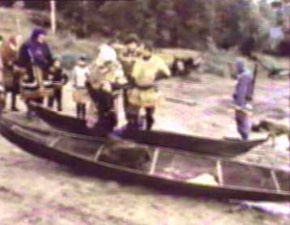 Fig 4A
Fig 4A:
OB RIVER
The concept of the original boat did not involve
frames and skins.
All boats were dugout logs. The dugout is still made by
the Khanti of
the Ob (image at right is from a Lennart Meri film produced in Estonia
in the 80's) However this dugout is small because at the northern edge
of the forest zone, the trees are too small to make large seaworthy
dugouts.
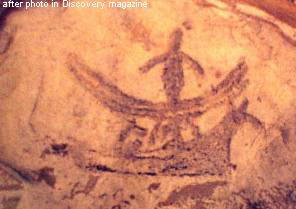 Fig 4B
Fig 4B:
ARCTIC NORWAY
A small dugout like the one of the Khanti is seen in the
top image
in the rock carving from arctic Norway, dated to some 6000 years ago.
But this small dugout was not adequate for dealing with the high waves
of the ocean, The image below it show the skin boat made from moose
hide, the moose head represented on the prow.
Boat people who wanted to harvest the arctic, could not use
the slim dugouts made from the small northern trees. They had to
develop something new. My theory is that it began with someone's idea
of trying to make a dugout from a dead moose carcass.
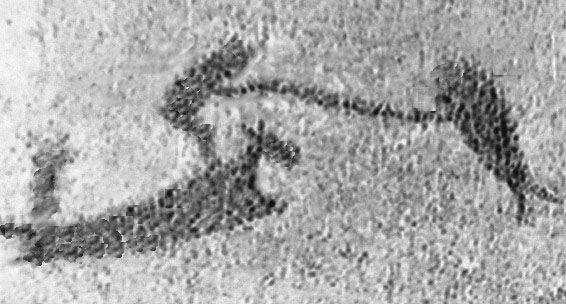 Fig 4C
Fig 4C
LAKE ONEGA ROCK CARVINGS
The
Lake Onega rock carvings present several examples showing the
small
moose skin boat being used in sea-hunting. Allowing for some
variation by the artist, the scale of the moose head is
generally of natural size, when compared with the size of the two or
three people inside.
 Fig 4D-E
Fig 4D-E
THE MOOSE AS A BOAT
All
the
skin-on-frame boats of the world owe their origins to this
beginning, which I believe began with applying the concept of the
dugout to a moose carcass. The idea may have begun with someone seeing
a moose swimming and initially thinking it was a large floating log.
Coming close they discover it is a moose; however the idea of making a
large boat was already planted in their mind and they wondered if a
boat could be made from it. In the beginning the idea of a skin on a
frame did not exist. It was born when the concept of the moose's ribs
was employed to hold the skin in shape.
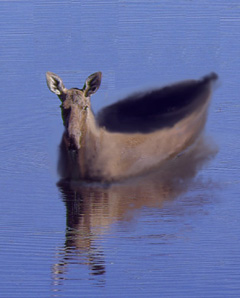 Note that the
moose has a massive body giving a great deal of skin that can
be
stretched to create a boat large enough to hold three men
Note that the
moose has a massive body giving a great deal of skin that can
be
stretched to create a boat large enough to hold three men.
Since the moose (shown above) is a forest
zone animal, the use of the moose meant that its users did not remain
in the arctic, but migrated between the arctic coast and forested
regions. It is interesting that the Lake Onega carvings show
no images of moose with antlers. Since males grow antlers in summer and
shed them in fall, it follows that the Lake Onega people were in the
Lake Onega area only in winter-spring. They then left for the arctic,
perhaps going as far as Alta, and did not experience the moose with
antlers. The Alta rock carvings also show boats with reindeer heads. It
suggests that those people who DID stay in the arctic, and did not
return south, used the reindeer as a substitute, sewing many skins
together.
The next step was of course the enlarging of this
boat, to hold many
more people. The obvious way to enlarge it was to simply sew skins
together and make it longer. The following images compares a rock
carving of a large boat at Lake Onega, with a typical UMIAK of the
Alaskan Inuit. The umiak shown was made of walrus skins, but it gives
an idea of size. Walrus skin was discovered to be a better
skin than reindeer skim, for those peoples who stayed in the arctic and
did
not descend south in winter to the forested regions where moose were
found.
Fig. 4F
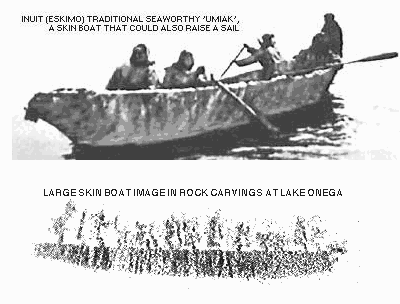
This, I believe, was the beginning of all the
subsequent boats that have ever been built - up to the oceanliners of
modern day - based on the principle of putting a skin on a frame. The
greatest oceanliner on earth starts 10,000 years ago with a moose
swimming across a lake and being initially mistakened for a floating
log.
The "dugout moose" was just the beginning. As the
rock carvings also show, pieces of skin could be sewn together, and
more frame added, in order to create a long boat capable of holding
20-50 people. See the story of the development of the skin boat
from dugout precedents in the below information box.
Rock Carvings Showing Whale Hunting in the White Sea as Early as 5000-6000 Years Ago
THE
DEVELOPMENT OF WHALING
The skin boat was designed to deal with the
high waves of the open sea. By lengthening the boat it could hold more
people, and a large boat with many people was needed to catch the
ultimate of sea creatures - the whale.
Figure 5
The
Lake Onega rock carvings large boat, obviously made of skins on a frame. The moose
head, perhaps now carved of wood instead of a mummified real head is
seen at the front. At the front of this image we see what is
pobably a seal.
The arctic boat people who developed whale
hunting, not only created large boats, but their quest for whales took
them far into the sea, as they searched for whales. Only those sea
people willing to take on whales
would ride the open sea as boldly as the whales themselves. These
people would have travelled from the White Sea region, both eastward
and westward along the arctic coasts.
But whales voyage long distances, and peoples who
had developed whaling skills, would have expanded into the large scale
world of the whales. They would have followed whale migrations south
along the Atlantic. They would have found whales
congregating at Greenland, and travelling up and down the east coast of
North America. There were whales, seals, and walrus as well to be found
in arctic North America. If these people reached the Pacific, they
would also have found whales, and come south along both Pacific coasts.
Did these people carry with them the language
spoken in the original Kunda Culture regions, today surviving within
Estonian and Finnish? We will explore this question in a separate
language to keep archeological and linguistic discussions separate.
How do we know that that some of these moosehead
skin boat peoples, of Lake Onega origins, mastered whaling? The proof
is starkly evident in rock carvings found at the While Sea.
The most amazing rock picture is the one shown below (presented here
intepreted in black and white, with the whale hunting event set appart
from other elements around it for clarity.)
Figure 6-7
Whale
hunting from moose-skin
boats, probably on the White Sea (in today's arctic Russia,
north of Lake Onega).
(Light grey restores missing, worn, sections) This image is developed from the fuller rock carvings site shown below.
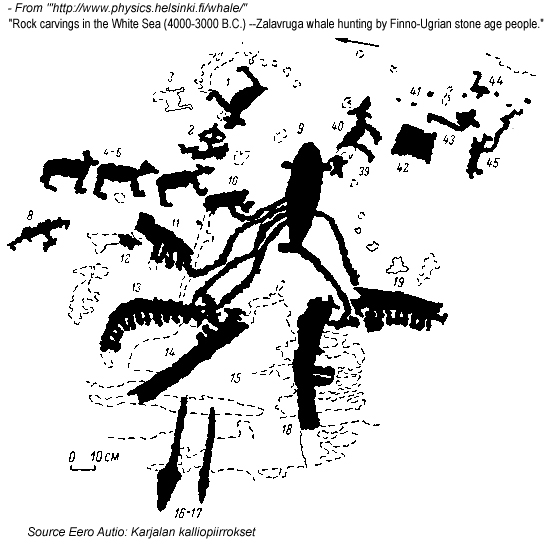
BELOW: THE WHALE HUNTING ISOLATED FROM THE REST
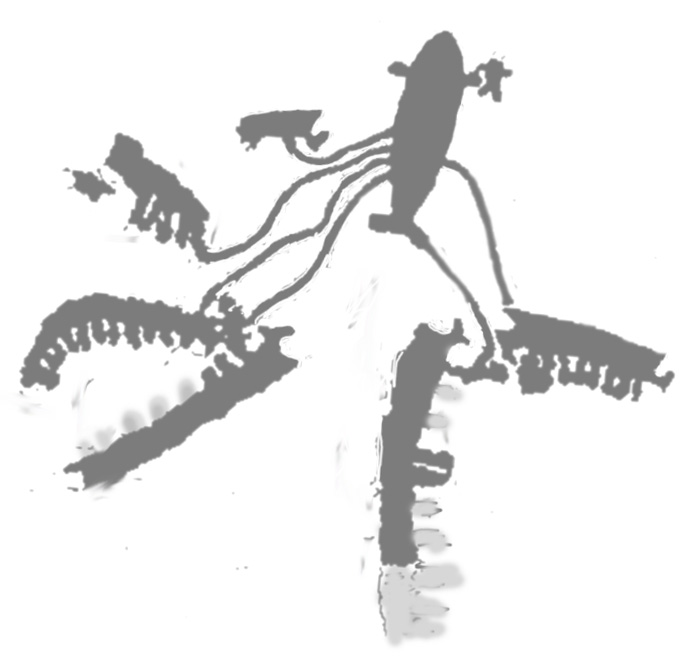
The above illustration is very surprising, because
it first of all proves that the large boat shown in the Lake Onega rock
carvings in Figure 5, is not some kind of fantasy boat, as early archeologists said.
It really existed. Note especially the small boats
accompanyng the large one. Apparently when the whale was entrapped, an
individual in a small boat would go to the eye of the whale, get into the water, and speak
to it, gain its approval and willingness to give up its life.
The White Sea illustration does not show anything imaginary.
It shows the same activity as witnessed in the 18th century and
recorded in the following illustration.
Figure 8
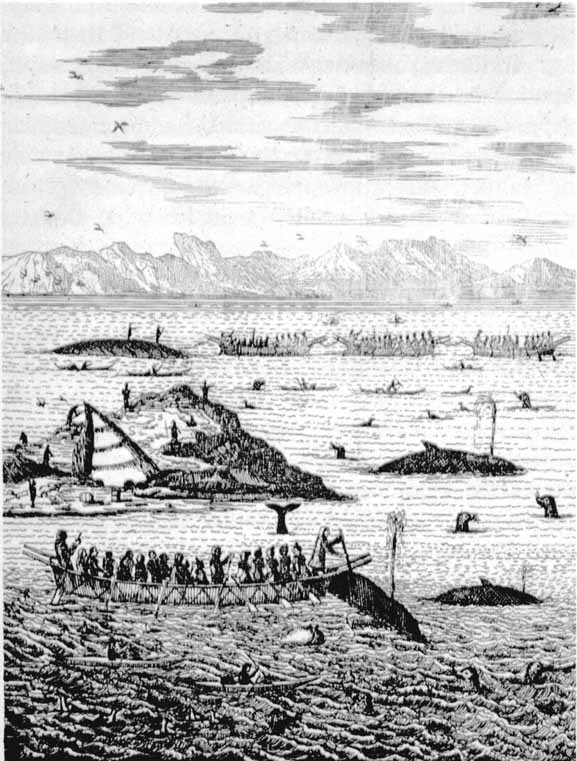
Greenland
'Eskimo' clans meeting to hunt whales
from Description
de histoire naturelle du Groenland, by Hans Egede, tr.
D.R.D.P. Copenhagen and Geneva, Frere Philibert (This image derived
from Canada's
First Nations: A History of Founding Peoples from earliest times
by O. P. Dickason, Toronto, 1992)
The Illustration of the Greenland Inuit shows only one large boat in
the foreground, but I think that is purely artistic liberty. The artist
sought to show everything in one image. The important part of the
illustration is that there are three large boats in the background, a
total of four boats. Each boat probably represents a clan. A tribe
consisted of several clans. For most of the year, each clan travelled
by themselves in their own territories, but the clans came together
once a year to carry out activities that were better done collectively.
It happens that whales congregated off the shore of Greenland.
The lack of a head on the prow of the skin boats in
the more recent illustration means the use of moose skins had long
ended since a portion of the the Lake Onega boat peoples remained in
the north (the Komsa Culture), The skins of these boats may have been
made from whale
skins (?). Secondly, I believe the skins were removed from the frames
and used for shelters like we seem to find on the island to the left.
(See EXPLAINING LONGHOUSE
"FOUNDATIONS" ON LABRADOR COAST for a more detailed
discussion)
Sea Hunters of the North Atlantic
As discussed earlier, aboriginal peoples, whether in the interior or on the seas, did not
wander aimlessly, but established annual rounds, visiting the same
campsites again and again every year, and each tribe established this
round and the harvesting sites as their 'territory'.
We discussed earlier how interior boat peoples,
settled on river systems, each extended family or clan, assuming one of
the branches of the river as their territory, and then every year all
the clans travelled down the river at an established time and place, to
live for a time all clans together, all the clans of the river forming
a tribe.
Organizing according to rivers was not possible for seagoing peoples. Since the
boats were mainly paddled and not dependent on wind, the annual
rounds of seagoing clans, would have been defined by ocean currents.
Whale hunting tribal territories would have
developed according to the behaviour of whales and not just ocean
currents (What point are currents if they don't take boats to the
hunting/fishing places?). Whales migrated up and
down Atlantic coasts, both on the European side and the American
side. Obviously tribes on one side would in the long run diverge
from those on the other side, as a result of reduced contact. When the
whale hunting culture reached the Pacific, it would also have descended
down the Pacific coast, that also has whale migrations. They could have
descended as far south as California, since whales did. If you are a
whale hunter, would you not wonder where they went, and try to follow
them?
Evidence that whale-hunting boat peoples
associated with North America came ultimately from the White Sea
culture, is proven by not just whale hunting traditions - which cannot
be easily aquired - but by the appearance of words that also appear in
Estonian and Finnish. But the linguistic evidence will be reserved for
a companion article to keep the archeological and linguistic story
separate.
While whales and the search
for large sea animals in general, like also seals and walrus, may have
been the original reason for boldly venturing into the open sea (quite
scarey until one is used to it), once there, the sea-going hunters also
had access to new places to pursue walrus., seals, and fish, and that would have caused the
culture to flourish and expand in some places, even without whales.
What evidence can there be found for seagoing boat peoples that did not pursue whaling?
Alta Norway, a Major Location that Was a Multi-tribe Meeting Place and Launching Place for Sea Voyages
THE
TRADITION OF MEETING PLACES
Alta, Norway is a location that must have been
the
meeting place for many tribes - tribes who were indigenous and
harvested the seas, tribes who arrived seasonally from the interior,
and possibly visitors from farther away. The nature practice of
nomadic peoples gathering regularly at established congregating places
was discussed earlier. Not just the gathering of clans that comprised a
tribe, but in loctions accessible by neighbouring tribes, multitribe
gathering sites became established everywhere among the boat peoples,
both seagoing or interior boat peoples.
Evidence that Alta Norway was a multi-tribe
gathering site is evident from the wide variety of images found on its
granite cliffs, not just in terms of subject matter but also artistic
style.
The visitors, finding granite hills engraved with
carvings, would have added their own at every visit. Such places where
many tribes congregate, to trade, exchange news, socialize, and
engage in common festivals are well known throughout the world of
northern hunting peoples.
The Lake
Onega region was one such place where many tribes congregated. The
region at the mouth of the Vistula
another. It is possible to predict such locations according to
the
organization of water systems. Such locations appear in archeological
investigations as different archeological "cultures" overlapping in
that area, suggesting they came together, camped near one another. It
is in such locations that sites of religious/spiritual nature can be
found.
Figure 10
THE ALTA,
NORWAY ROCK CARVING SITE
The Alta area has granite ridges,
and because granite is
hard, it has
been determined that the carvings are between 6200-2000 years old. This
means it was begun by the earliest skin boat peoples who visited the
warmed waters off the coast - waters warmed by the North Altantic
Drift that reached the arctic Norwegian coast.
But the Alta site continued to recieve tribes both
from along the coast and from the interior, as suggested by the fact
that carvings are as new as 2000 years ago with some examples as late
as 500 years ago. One can argue that a site that starts a tradtion of
rock carvings both attracts more carvings, and in general grows in
importance as a congregating site. The following information box
shows some images from the site (images stolen from the internet)
Figure 11,12,13
The congregating site was
very important to nomadic hunting peoples because they moved around the
environment as clans for most of the year, and needed to meet each
other to share news, find mates, and carry out celedbrations.
It is obvious from
common sense that eventually some
arctic seagoing people would no longer travel south in the winter, this
is clear too from the fact that the Alta carvings show a large number
of skin boats with reindeer, not moose, heads.
But throughout its history the Alta site would have
attracted peoples from the interior, from the Scandinavian interior,
rather than for the Lake Onega area which was considerably further
away. As the map shows Alta was located north of the mountain range and
could be reached from rivers descendng into the interior.
Figure 14
Most of the carvings, from more recent times
generally reflect the historic "Finn" culture in general, which
originally was found in seagoing and forest peoples, and not just the
reindeer herders that have survived into modern times. (The original
word "Finn" became "Lapps" and as later as the early 20th century,
there were "Forest Lapps" and "Fisher Lapps" as well as the "Reindeer
Lapps". Today the word they prefer is "Saami")
It is easy to see why. when the Germanic Norway was
created, the regions to the interior was called "Finnmark". Towards the
east there was "Finnlanda". It underscores the fact that the "Finns",
were the indigenous peoples, But there has been debate as to how
they relate to the Finnish who cover the same landscape in the form of
today's Finland. An obvious answer it that they are almost the same,
since when Finland became a country there was no sharp distinction
between the natives in the wilderness and the "Finns" in the more
developed southern Finlands.,
The Further Expansions of the Seagoing Skin-Boat People
READING
THE EVIDENCE IN ARCTIC SCANDINAVIA
The rock carvings found at Alta Norway tell a story
about people coming there
to harvest the rich sea life off the arctic coast of Norway, where the
warm waters of the Atlantic Drift (originating as the Gulf Steam on the
American coast) ended up. Originally they would have travelled there
seasonally, and then returned south in the dark and cold winter. But
then some stayed. The "Komsa" archeological culture at the top of
Norway, that camped all winter at the mouth of the Teno River, was one
of the first cultures that remained all year, enduring the sunless
winter months. The Alta carvings also suggest there were people there too who
stayed, because of the many images of boats with reindeer heads on the
prows, not moose heads. The large moose-head skin
boats, such as depicted in the White Sea rock carving of whale hunting,
speak of returns south into Lake Onega, where winter was spent hunting
moose on skiis (There is an image at Lake Onega of a man on skiis following a
moose).
While the many rock carvings of skin boats, and the
hunting of seals and whales prove that the descendants of the Kunda
culture were at the White Sea, islands of arctic Norway, and in the
vicinity of Alta, Norway.
While we can logically predict that there people
could have followed currents and formed three tribes according to
the capability of having a circular seasonally migratory route in the
Atlantic..See the map of Figure 9. If these boat peoples expanded
further, it would have been according to ocean currents.
How can we detect such long distance oceaning
migrations of boat peoples? One way would be to look at language, to
see if it has strong suggestions of an ancient Finnic language. But the
strongest indication of the migration of seagoing boat people culture
is he skin boat, particularly if it kept the tradition of the
animal head on the prow. When the purpose of it was forgotten,. it may
have become fantastic, and become the so called 'dragon boat'.
The head on the prow of a vessel
is a
phenomenon that has endured down through time, and its last
manifestation has been the hood ornament on the modern automobile or
truck, particularly if the ornament represents an animal. In culture we
do such things, and we do not know why; but some customs can have roots
that are many thousands of years old.
Whale-hunting traditions have
endured on the Pacific coast, particularly in Native peoples of the
region around Vancouver Island and to its south.(Peoples of the
"Wakashan" languages) There, memories of whaling are still strong, and
attempts are being made to recover the culture. If you look at the
graphics painted on the large dugouts of the Pacific coast, you will
see eyes painted on the front. If asked, the artist may say it is to
help guide the way, but it may tell another story. Because of the giant
cedar trees of the Pacific coast, whaling peoples arriving there were
able to return to the creation of seagoing dugouts. They may have
arrived in skin boats made of whale skin, with the whale head
represented by painting its eyes at the front. Converting to the cedar
dugout, the continued to paint the eyes at the front. It had to have
occurred this way, because such a practice of representing the head of
an animal at the front has never existed in the dugout boat tradition.
The coincidence between Pacific coast seagoing dugouts having an eye
painted on the front, and the whaling traditions cannot be assigned to
random chance!!
SOUTHWARD
MIGRATIONS
Thus, besides circumpolar expansion of the
sea-going skin-boat peoples, there was venturing southward. The main
inspiration for southward exploration would have been the north-south
migration of some species of whales. Encountering whales at the south
tip of Greenland, the whaling people could have followed them as they
left, down the coast of Labrador. But already whaler peoples in arctic
Norway could have followed whales too as they migrated back south along
the coast of Europe.
On the North American side, this
southward venturing could
have led to the birth of the Algonquian
Native cultures, whose languages at the time of European
colonization (16th century) was found to cover the entire northeast
quadrant of North America, in a manner consistent with boats making
their way up all the rivers that drained to the coast. The Algonquian
boats were dugouts everywhere except along the coast and where birch
trees were plentiful. Along the coast there were skin boats (including
those made of moosehide), and in the northern regions that had birch
bark, skin boats were made of skins of birch bark sewn together.
Obtaining birch bark was clearly easier than obtaining a moose hide.
Besides, a moose hide had other uses.
Purely from geography, currents and winds alone, it is almost certain
that the Algonquian birch-bark canoe peoples descended from the north,
not just along the Labrador coast in the same way the Norse came
millenia later, but from Hudson Bay, The arctic was inhabited first by
the arctic skin boat peoples of the White Sea spreading around the
arctic coasts (which is not such an enormous distance - maps tend to
stretch the arctic. And then the skin boat peoples were drawn southward
by the warmth. The lands may have been flooded, but they had boats. One
consideration is that the glaciers had to be significantly disppeared
because fresh glacial meltwater has not yet acquired aquatic
life.
Thus If we are looking for the
survival of the older "Dorset" traditions, it would probably be in the
Algonquian cultures. The Great Lakes Algonquian legends speak of
origins in the east, at the mouth of the Saint Lawrence., but I don't believe the Cree around Hudson Bay, have such legends,
Newfoundland
had up to historic times a Native group called the Beothuks, whose
culture first manifested there in the early centuries AD. But we
cannot dismiss the possibility that there have been many waves of
oceanic peoples first inhabiting the arctic in skin boats and then out of curiosity
venturing southward along the Labrador coast, moving with the same
winds and currents as the Norse around 1000AD.
Figure 17
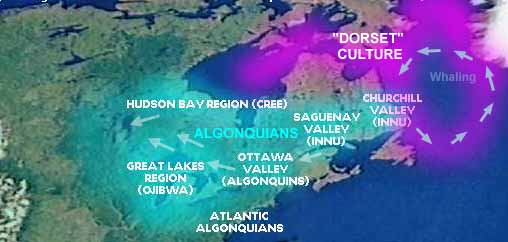
On the European side there would have been southward
migrations too. Archeology identifies seagoing peoples on the
Atlantic coast of Europe as early as 4500BC, on account of the
"megalithic" (made of enormous stones) constructions from southern
Portugal to northern Britain, taking either the form of large burial
chambers covered with mounds, or stone circles and alignments. The
oldest megalithic stone alignments are found at Carnac, France, in
southern Britanny. The famous "Stonehenge" was a relatively late
development from the same general culture. The oldest
constructions were all found close to the sea, and widely distributed
in southern Portugal, Brittany, coasts on either side of the Irish Sea,
Orkney Islands, and even across to the north end of the Jutland
Peninsula by 2000BC. It suggests a trading people that eventually
promoted their culture inland up the rivers, eventually making eastern
Europe generally a culture of this nature.
Figure 18
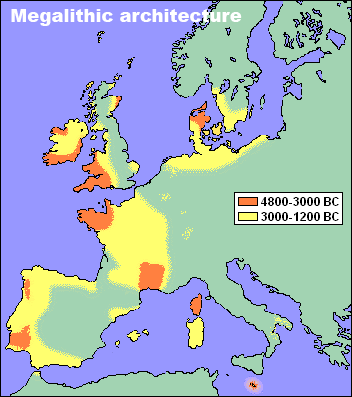
source: internet. url not found
The
above map is a good one showing the early and later cultures that build
constructions with large stones. Do not be confused by the large
coloured areas. In reality they should be dots. But it generally shows
(orange) that there people travelled the Atlantic. They may have begun
following whales or even eel migrations, but then became traders to
interior less mobile peoples. In any event, there were boat peoples in
the Atlantic about the same time as arctic skin boats spread around the
arctic. Because the arctic peoples were familiar with camping on barren
islands with only rocks to build with, it stands to reason that the
megalithic structures were in fact their normal practical everyday
structures constructed in a large glorifying manner.
Any thinking that these megalith building boat
peoples originated anywhere else but in the north begs us to wonder
what environmental circumstances occurred elsewhere to force humans -
land people - to go out into the frightening open sea. As we discussed
earlier, the postglacial flooded lands of northern Europe provided no
alternative but to develop the use of boats..
These mysterious megalith building
people certainly knew
how to travel in the open sea, and may have created more wealthy
cultures towards the south, off Portugal, and been the source of the
legends of Atlantis, first brought forward by Plato, which he claimed
ultimately came from Egyptian priests. They may have crossed the
Atlantic in the middle, leaping from island to island, with the Azores
in the middle of the Atlantic being the half-way point. This would
especially be true for people who began to harvest eel migrations
coming through the Strait of Gibraltar and English Channel, because
Atlantic Eels are born at the Sargasso Sea near Bermuda etc. A people
who discovered this would have learned about North America and
"Atlantis" would have been, in fact, North America, since originally
the presense of a continent between Asia and Europe was unknown.
But the southward-migrating sea peoples, may
have merged in their southward migrations with dugout-peoples, and the
skin-on-frame approach of boat design, caused the evolution of the boat
made of planks on a frame. The original dugout became the keel,
and ribs arising from it could then take boards, to initiate a new
approach that combined the best features of both original designs.
The most important principle in boat design was the
displacement of water. The boat with a hull that displaced water with
essentially air achieved greatest buoyancy with least weight. The frame
with skin/hull was the way to create to greatest water displacing space
with least materials.
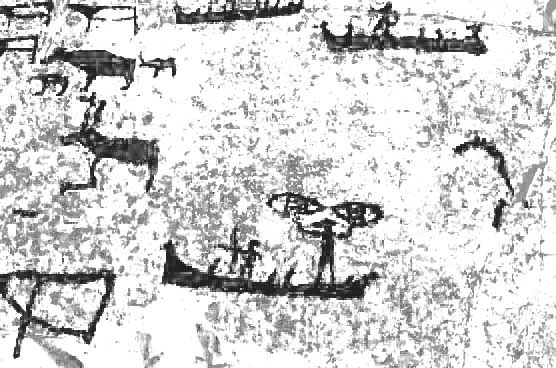
Figure 19
These images
from
the Alta carvings
depict skin boats made of reindeer skins engaged
in fishing with nets
Regardless of how Atlantic seafarers evolved towards
the south,
their northern cousins carried on generation after generation. The
activity was not focussed entirely on large sea-mammals (whales,
porpoises, seals, walrus, etc) but there was plenty fishing. Nets could
bring in large quantities which could then be salted and smoked.
If these seagoing skin boats were
at Alta, they were also elsewhere in the sea too, down the Norwegian
coast, and in the British northern isles.
The North Atlantic Appoaching Historic Times
SEAGOING
SKIN BOATS OF THE BRITISH ISLES
The sea-going peoples of the
British northern isles obviously originated from the arctic skin boat
peoples because they have always used skin boats. When walrus became
extinct in the British northern isles, the people there, the "Picts",
made skin boats from ox-hide. The Irish called them curraghs. The
following illustration comes from an 18th
century illustration. To my amazement, it appears to have an
oxhead, at the prow, adhering to the ancient tradition of the
head of the animal whose skin was used being put at the prow.
Figure 20
18th century illustration shows 'wild Irish' in a 'curragh' - a
skin boat of ox hides - note the head of the ox at the prow,.
suggesting an origin in the arctic Norwegian skin boats
Author Farley Mowat, has searched historical
material for everything he
could find about the skin-boat peoples of the northern British Isles,
and established from historical quotes with great certainty of British
islands and coast being inhabited by peoples who travelled everywhere
even long sea voyages in skin boats.(Farfarers,
Toronto, 1998) However
he failed to make any connection between them and the skin boat
traditions across the Scandinavian arctic.
In whatever way they
evolved among the British Isles, it is clear they originated from the
same culture as depicted in the rock carvings of Norway. Why did they
become involved with the northern British islands? The answer lies in
the North Atlantic Drift, a warm current that originated in the Gulf of
Mexico and known as the Gulf Stream. The warm current was ricn with sea
life. It proceeded northward to the west of the British Isles, on its
way to the arctic coast of Norway. But a branch of it turned eastward
through the British northern Isles. The Orkney Islands there, are
believed to have once had great walrus herds. Walrus skins would have
been the skins used by early "Pict" sea peoples of the outer islands
and coasts.
In the first century AD, the
Romans had invaded the British Isles and were establishing armies in
various locations, including in the North, to assert control
everywhere. There is no question that if there were people of the open
seas in the outer British Isles, they would have fled from the Romans,
and settled elsewhere. I find it not a strange coincidence that,
according to archeology, the Beothuks of Newfoundland , according to
archeological dating, appear about the
same time as the Romans are asserting control over the British Isles.
The word that "Beothuk" represents, has similarities with some
variations on names applied to the Picts. For example Anglo-Saxon "Peohtas". Norse hardened it to "Peti"
When Greeks and Romans ventured
north into the British Isles, they heard of an island in
the North Atlantic called "Thule" which has been identified as Iceland.
(Note: The name "Thule" for the North American archeological culture
has no connection to the historical "Thule". Archeologists used that
name based on the region, so named, in northwestern Greenland
where the archeological culture was first archeologically identified
among the earlier "Dorset").
APPROACHING HISTORIC TIMES
There
is no question that there once existed an "Atlantian" people.
They travelled the north Atlantic ocean, camping on islands, as we can
see in the illustration of Greenland Inuit whale hunting. They were
short people, and that is to be expected too, as an adaptation. People
who travel extensively by boat need strong upper bodies, but can have
short legs (Short legs on large torsos can be still seen among the
Inuit - short legs are also good for reducing loss of body heat)
Author Farley Mowat (Farfarers, 1998), pictured a people he called
"Albans" based in the British northern islands. He pictured them being
most interested in walrus, and travelling as far as the Labrador coast
to obtain walrus ivory to sell in Europe. In his book Farfarers,
Mowat's view of the skin boat
traditions of the northeast Atlantic was far too narrow, however. He
made no mention of the rock paintings of skin boats in Norway, and made
no connection between the Norwegian examples of skin boats and the skin
boats of the British Isles, recorded in historical records and
surviving through the centuries as the Irish "curragh".
We can read with interest however
when
Farley Mowat reveals that in the traditions of the Shetland Islands in
the north of the British Isles, sea-harvesting peoples called the
"Finns" appeared.
Existing Shetland traditions speak of
a people called Finns who
inhabited Fetlar and northwest Unst for some time after the Norse
occupied Shetland. This name is identical with the one by which the
Norse knew the aboriginals of northern Scandinavia. It is also the name
given by Shetlanders (of Norse lineage) to a scattering of Inuit (sic).
who, in kayaks, materialized amongst the Northern Isles during the
eighteenth century.. (Mowat, Farfarers: Before the
Norse, p 110,
Toronto, 1998)
But it did not occur to Mowat that these were
the same people as the ones he was looking for, and not some other
people. He was looking for people closer to himself - settled people
living on the coasts - and thus did not seriously consider "Finns" to
have been identifiable with "Sea-Lapps" from the Norwegian coast, and
that possibly they were less primitive than the Inuit/Eskimo he assumed
they were.
The difference between the Altantic seaharvesters that
were called "Finns", and those who left a record of skin boat use in
the British Northern Isles, may be simply that the latter became more
localized by becoming more involved with the economies of the interior
of Britain. There is indeed proof that skin boat peoples of the British
Isles were more localized than their migratory ancestors, and
found everywhere on the coasts, at least on the west side. According to
Mowat in Farfarers, the Roman poet Avienus, quoting fragments from a
Carthaginian periplus (seaman's sailing directions) dating to the six
century B.C. described a rendevous with native British in skin boats as
follows.
To the Oestrimnides [Scilly Islands]
come many enterprising people who
occupy themselves with commerce and who navigate the monster-filled [ie
walruses, seals, whales, propoises, etc] ocean far and wide in small
ships. They do not understand how to build wooden ships in the usual
way. Believe it or not, they make their boats by sewing hides together
and carry out deep-sea voyages in them. (quotes in Mowat,
Farfarers)
The people described in the above
passage are clearly not the long ranging oceanic aboriginals, but still
they are probably descended from them. Finding good conditions in the
British Isles, and the ability to trade wares from the sea for other
goods, they would have formed an intermediate culture. They
exploited land resources and trade, (such as keeping sheep and goats on
various islands roaming wild, to harvest from time to time when
they stopped there).
After the Roman Age, developments of boat peoples along the Norwegian
coast lead to the continued use of the principle of the skin on the
frame in boats covered with plantks. With the connection between the
skin and the head on the prow gone, builders were free to make up their
own wood carvings to put on the prow.. It gave rise to the
"dragon
boat" concept.
The presence of the "dragon-head" in Norse vessels
demonstrates that the Germanic conquerors of the Norwegian coast
(800-1000AD) became identifiable with seafarers purely from the Finnic
natives starting to speak the Germanic language (Norse), and
participating in the new Norse culture. The idea of Vikings originating
from Germanic heritage is false. Vikings originated from the indigenous Finnic
boat
peoples, and became speakers of Germanic Norse in much the same way
that North American Native peoples have recently become English speakers..
Another important historical reference
presents us with another truth that ought to be obvious - that the skin
boats of the British Isles crossed the waters to Norway as well. This
comes from Pliny the Elder dated to 77 A.D. in which he writes about
information from an earlier historian Timaeus whose original work has
been lost.
The historian Timaeus says that there
is an island named Mictis lying
inward six day's sail from Britain where tin is found and to which the
Britons cross in boats of osier covered with stiched hides. (Pliny,
NaturalHistories,
IV, 14, 104.)
Mowat suggests that this place called
Mictis might have been
Iceland. However if the skin-boat seafarers of
the British Isles had an intimate relationship with any location it may
have been the Lofoten Islands of Norway. We also note that since the
Gulf Stream flowed past the British Isles and north towards the
Lofotens, then the sailing was with the current.
Thus we can accept that many of these
oceanic skin-boat peoples, who ventured away from the Norwegian arctic
waters where they began, and then became localized among the British
Isles, tended to sheep on land behind their huts, and traded with
interior peoples; but at the same time the traditional way of life
would have continued as well: there were also the long-range migrations
of traditional oceanic people, who made circuitous migrations
from one sea harvest area to another. They would be the ones who would
camp
for a time on outer islands (like the Shetlands) to use as a home base
for harvesting the surrounding seas. The "Finns" of Shetland traditions
were not, I'm certain, accidental visitors of Inuit. I think they were
people who deliberately migrated in a circuit which touched on Iceland,
Faroes, Shetlands, and Norway.
SEA PEOPLES OF THREE NORTH ATLANTIC OCEANIC CIRCUITS
The map below, shows
the currents of the North Atlantic and how we are able to identify
three 'territories' - A, B, C.
Figure 21
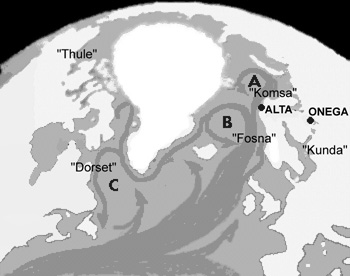
Map shows ocean currents
of the North
Atlantic and some of the names mentioned in this text. The names in
quotes represent archeological "cultures". ALTA and ONEGA name two
major locations of rock carvings showing boats, dating to 6000 years
ago. The letters A, B, C show areas where currents loop around. Since
early boats were not particularly wind-driven, they would have been
oriented to currents, and each of these loops could have defined a
tribe undertaking migrations that may have lasted many years before
returning to the same place.
Looking at the map above, showing how the ocean
currents
circulate in the north Atlantic, it is likely that the "Finns"
who touched on the
northern islands of the British Isles, can probably be identified with
the "Fosna" archeological culture of Norway, or at least, that part of
them who would have migrated in current circuit "B" (see map). These
oceanic people would have had no
interest in making their way into the dangerous surf close to the
coasts. They appear to have preferred camping in the outer islands
close to their fishing/hunting sites. Such
people would have travelled, through a year (or possibly several
years), between
the Lofotens of Norway, Iceland, and then back via Faroes and Shetland,
and then back to the Lofotens. They would time it to meet up with other
clans at a common congregating site.
As mentioned earlier, these people of circuit "B"
would also have stopped in the British outer islands (such as the
Shetlands, mentioned by Mowat). But a breakaway tribe must have
remained in the British Isles to become the peoples seen by visitors
over a millenia ago travelling in skin boats (which Romans called curucae and Celts called curraghs) in the remote coasts of
British Isles, mainly in the north and northwest.
According to historical references after the arrival of
Christianity Irish monks sought to get away from civilization to live a
solitary meditative life. They headed north into the outer islands, and
there they encountered short people who created dwellings that
resembled igloos made of
stone, that is, domes (or near domes with a small roof) created by
piling rocks round and round, sealed on the outside with sod so that
they were like underground houses. (Note that arctic Norwegian
dwellings were similarly semi-buried and often using sod to seal the
roof.) These short "Peti" (As a Norwegian text called them) that the monks encountered, appeared
also to have left goats and/or sheep to run wild on grassy
islands, so that when they returned to these islands they would be able
to harvest them for meat to supplement their seafood diet. Obviously
those "Picts" who became more settled, if any did,
became more diligent breeders of these sheep and goats. Such islands
would have been ideal for monks - there they would have solitude but also have familiar goats
and sheep to survive on. We are speaking of early Christianity in Ireland, shortly after the collapse of the Roman Empire.
Looking further in circuit "B", we can expect that
the seagoing peoples of circuit "B" also visited the outer islands
towards the east side of Iceland. This is confirmed by history
and archeology - which affirms there were aboriginal peoples,
Eskimo-like people who were inclined to
camp on the outer island close to the areas they fished and hunted.
Since these were seasonally migratory people, foreign observers would
never observe them to be settled anywhere. They would never need to
build any permanent dwellings anywhere.
Thus the absence of any early
permanent settlement on Iceland should not be construed as Iceland
being unknown. It was known, alright - by aboriginal peoples. They were
known by the "Picts" and "Finns" too insomuch as they themselves were
aboriginal or semi-aboriginal. Therein lies the problem in
Mowat's Farfarers
- he cannot accept that the people he envisions - the
"Albans" (one group among the Pictish north of the British Isles)
- were more primitive, more like Greenland Eskimo, than he wants
to admit. Scholars have tended to want to relegate aboriginal
peoples to the background, like wild animals and require that only peoples
who did anything interesting qualify as being "civilized".
The exception has been archeologists
and anthropologists. They do not discriminate between civilized and
uncivilized. For them it is perfectly acceptable to envision aboriginal
seafarers who may have migrated
throughout the arctic waters, and known all about Iceland, the North
Atlantic, Labrador, etc. - already maybe 5000-6000 years ago. But there
remains a racist perspective which implies "aboriginals do not count",
and so there are endless debates as to whether the Norse landings
around 1000AD were the "first" or whether there were earlier
landings on Labrador or Newfoundland coasts, by Irish monks; or some
other group. Who cares? Aboriginals always knew, and European seagoing
aboriginals from the Alta area, visited and perhaps stayed millenia
ago. Archeology has found evidence of contact with Europe - primitive
aboriginal Europe -dating long before the "Norse" visits to "Vinland".
The Basques as Southern Descendants of Sea Peoples
I believe that all the Atlantic oceanic people
originated from the same
origins - the skin boat peoples who harvested the seas off the coast of
arctic Norway. That was their training ground. Once they had
mastered their way of life and their populations grew, some wandered
south, discovered the British Isles, and then with continued success,
some continued further south.
That brings us to the question of the Basques. The Basques
in recent centuries have been well known as harvesters of the Atlantic,
including whaling in the waters off the North American coast from as
early as the 16th century. It is easy to believe that they are
descended from the same world of oceanic seafarers as the Picts,
Norwegian "Finns", and the Inuit. One does not learn to be at home on
the waters of the Atlantic overnight. (Similarly the Portuguese have
the same origin, except that the coastal Portuguese have lost their
original language in much the same way as the original people of the
Norwegian coast did.)
The Basque language, is acknowledged to
be pre-Indo-European. Some scholars assume that the Basques are
descended from the original peoples of nearby regions dating back to
the cave people who left art on cave walls. However, we have to
recognize that there were two types of people during the
pre-Indo-European civilization in Western Europe - the seagoing people
and the interior people. The Basques display strong seafaring
traditions, and therefore it is reasonable to propose that they are
descended from the Atlantic seagoing peoples and not interior peoples.
The Portuguese too would have roots in sea peoples, except they changed their language during the Roman Era.
This connection to seafaring in turn implies that
they are distantly related to Pictic, Finnic, and Inuit cultures, to the peoples
of the expansion of boat-peoples. While it is possible the Basques
learned whaling in the modern era, it is equally possible that the
Basques have always known whaling, and have had an ancient connection
with
peoples like the Greenland Inuit whalers. We don't know very much about
what the Basques did in ancient times.
The whole story of the expansion of boat peoples of
the Kunda Culture also to the oceans, starting with the White Sea,
presupposes that all the peoples that followed carried elements of the
original culture. Is it possible Basque culture offers such elements?
Linguists have observed that the
grammatical
structure of Estonian and
Basque are similar. There are also many similar words,
although they could have come at a later time from the boat peoples
language becoming the language of Atlantic long distance trade from
about 5,000 years ago or so, since the Baltic Kunda culture developed
into seafarers of the Baltic, and then into seatraders when the settled
peoples of the interior of Europe developed a need for tin 'from the
ends of the earth' as Herodotus wrote.
So we cannot say how much of Basque comes over the
top of Scandinavia in skin boats, and how much comes through the North
and Baltic Seas in wooden boats.
We will explore the linguistic evidence of the
expansion of the seagoing boat peoples in a separate article, to keep
the discussions of languages separate. However, something can be
mentioned here:
The most interesting word in Basque from the
point of view of sea-peoples is the Basque word for 'water' which is ur.
This word exists, in my view, in the name "Uralic Mountains".
Perhaps we can allow ur
to be an abbreviation of UI-RA.
The -RA is a widely used element of the ancient world, appearing in
association with travel-ways. Furthermore, the Basque allative case
ending (motion towards) is -ra.
Combining this with the appearance of
UI in the name Uitoriges,
menioned in several ancient texts including Julius Caesar, suggests it is possible Basque ur
is indeed an abbreviation of UI-RA, 'the way of the floating,
swimming'. It
obviously the ancestral language to Basque did not view 'water' originally as the liquid but as the sea
over which the seafarer travelled, the water surface over which boats travelled..
The Basque word for 'earth' appears to add an
L to ur producing lur. But it is more likely from
ALU-RA,
'land-territory path'. ALU (Estonian alu
'base, foundation, territory')
is reflected in Basque ola
meaning 'place (where something is done)'.
Thus here once again the Estonian interpretation mirrors something in
Basque, indicating too that Basque and Estonian were closer at an
earlier time. The chances of the Basque lur being based on ALU is
supported by the fact that in Roman times the stem ALU occurs several
times, especially in the Roman name Albion
but more clearly in the
Greek Alouiones (read
ALU-AVA-N). If the native British used ALU or ALO
'land-base', 'territory' as the stem for some geographic names, then we
can expect that the ancestors of the Basques did too, since in
seafaring terms both places were part of the same early Atlantic world.
We continued discussions of languages in a separate article.
SUMMARY:
ABORIGINAL SEAFARERS IN THE EAST ATLANTIC
The theory of an eastern north Atlantic
aboriginal seafaring people who moved with the currents in a circuit
that touched the coasts of Norway, Iceland, Faeroes, Shetlands,
northern Britain and back to Norway is undeniable, and it gives us a
framework for interpreting historical accounts about "Finns" in the
ocean.
But as we look southward, the millenia of
involvement of civilization, has made it more difficult to interpret
early events in the British Isles and southward along the Atlantic
coast. It is easier to look westward, where aboriginal cultures
endured, less mixed up with other peoples and their influences.
The only clear whaling peoples in the east Altantic
are the Basques. Basques are today modern people and it is difficult to
find the evidence of the deep past. But there are two ways of doing so.
First of all a people so dedicated to the Atlantic ocean, and to
fishing and whaling, is likely to have had it a long time. Just like
reindeer people, the way of life is so specialized, and intimately tied
to the environment, that people who have it cannot easily switch.
Whaling, like reindeer management, isn't
only a recently acquired interest.
SOURCES
AND REFERENCES
Since this webpage has been
constantly updated - edited and changed - sources and references are
acknowledged where possible in the text or beside the picture. If a
statement is made or picture shown, without a source, that means the
image is either fully original by the author (A.Paabo)or significantly
modified artistically. One book that has special signifiance to this
project is: Eesti Esiajalugu, Jaanits et al, 1982, Tallinn.
author: A.Paabo, Box 478,
Apsley, Ont., Canada
2013 (c) A. Pääbo.
 <MENU
<MENU
